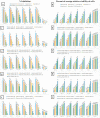The Antimicrobial, Antioxidant, and Anticancer Activity of Greenly Synthesized Selenium and Zinc Composite Nanoparticles Using Ephedra aphylla Extract
- PMID: 33809976
- PMCID: PMC8005055
- DOI: 10.3390/biom11030470
The Antimicrobial, Antioxidant, and Anticancer Activity of Greenly Synthesized Selenium and Zinc Composite Nanoparticles Using Ephedra aphylla Extract
Abstract
The current work aimed to synthesize selenium and zinc nanoparticles using the aqueous extract of Ephedra aphylla as a valuable medicinal plant. The prepared nanoparticles were characterized by TEM, zeta potential, and changes in the phytochemical constituents. Hence, the phenolic, flavonoid, and tannin contents were reduced in the case of the prepared samples of nanoparticles than the original values in the aqueous extract. The prepared extract of Ephedra aphylla and its selenium and zinc nanoparticles showed high potency as antioxidant agents as a result of the DPPH• assay. The samples were assessed as anticancer agents against six tumor cells and a normal lung fibroblast (WI-38) cell line. The selenium nanoparticles of Ephedra aphylla extract revealed very strong cytotoxicity against HePG-2 cells (inhibitory concentration (IC50) = 7.56 ± 0.6 µg/mL), HCT-116 cells (IC50 = 10.02 ± 0.9 µg/mL), and HeLa cells (IC50 = 9.23 ± 0.8 µg/mL). The samples were evaluated as antimicrobial agents against bacterial and fungal strains. Thus, selenium nanoparticles showed potent activities against Gram-negative strains (Salmonella typhimurium, Pseudomonas aeruginosa, Klebsiella pneumoniae, and Escherichia coli), Gram-positive strains (Bacillus cereus, Listeria monocytogenes, Staphylococcus aureus, and Staphylococcus epidermidis), and the fungal strain Candida albicans. In conclusion, the preparation of nanoparticles of either selenium or zinc is crucial for improved biological characteristics.
Keywords: Ephedra aphylla; antimicrobial; antioxidant; aqueous extract; cancer; cytotoxic; nanoparticles; oxidation; selenium; zinc.
Conflict of interest statement
The authors declare no conflict of interest.
Figures






Similar articles
-
Green and ecofriendly biosynthesis of selenium nanoparticles using Urtica dioica (stinging nettle) leaf extract: Antimicrobial and anticancer activity.Biotechnol J. 2022 Feb;17(2):e2100432. doi: 10.1002/biot.202100432. Epub 2021 Nov 21. Biotechnol J. 2022. PMID: 34747563
-
[Antimicrobial activity of soft and purified propolis extracts].Medicina (Kaunas). 2008;44(12):977-83. Medicina (Kaunas). 2008. PMID: 19142056 Lithuanian.
-
Phytochemical Analysis, Ephedra Procera C. A. Mey. Mediated Green Synthesis of Silver Nanoparticles, Their Cytotoxic and Antimicrobial Potentials.Medicina (Kaunas). 2019 Jul 12;55(7):369. doi: 10.3390/medicina55070369. Medicina (Kaunas). 2019. PMID: 31336944 Free PMC article.
-
New insight into the synthesis, morphological architectures and biomedical applications of elemental selenium nanostructures.Biomed Mater. 2021 Feb 25;16(2):022010. doi: 10.1088/1748-605X/abc026. Biomed Mater. 2021. PMID: 33629664 Review.
-
Selenium Nanoparticles: Green Synthesis and Biomedical Application.Molecules. 2023 Dec 15;28(24):8125. doi: 10.3390/molecules28248125. Molecules. 2023. PMID: 38138613 Free PMC article. Review.
Cited by
-
Evaluation of Antibacterial Activity of Selenium Nanoparticles against Food-Borne Pathogens.Microorganisms. 2023 Jun 7;11(6):1519. doi: 10.3390/microorganisms11061519. Microorganisms. 2023. PMID: 37375021 Free PMC article.
-
Limoniastrum monopetalum-Mediated Nanoparticles and Biomedicines: In Silico Study and Molecular Prediction of Biomolecules.Molecules. 2022 Nov 18;27(22):8014. doi: 10.3390/molecules27228014. Molecules. 2022. PMID: 36432115 Free PMC article.
-
Advances in nephroprotection: the therapeutic role of selenium, silver, and gold nanoparticles in renal health.Int Urol Nephrol. 2025 Feb;57(2):479-510. doi: 10.1007/s11255-024-04212-4. Epub 2024 Sep 23. Int Urol Nephrol. 2025. PMID: 39312019 Review.
-
Biologically synthesized black ginger-selenium nanoparticle induces apoptosis and autophagy of AGS gastric cancer cells by suppressing the PI3K/Akt/mTOR signaling pathway.J Nanobiotechnology. 2022 Oct 8;20(1):441. doi: 10.1186/s12951-022-01576-6. J Nanobiotechnology. 2022. PMID: 36209164 Free PMC article.
-
Biochemical and pathophysiological improvements in rats with thioacetamide induced-hepatocellular carcinoma using aspirin plus vitamin C.BMC Cancer. 2023 Feb 21;23(1):175. doi: 10.1186/s12885-023-10644-5. BMC Cancer. 2023. PMID: 36809998 Free PMC article.
References
-
- El-Shahaby O.A., El-Zayat M., El-Fattah G.A., El-Hefny M.M. Evaluation of the biological activity of Capparis spinosa var. aegyptiaca essential oils and fatty constituents as Anticipated Antioxidant and Antimicrobial Agents. Prog. Chem. Biochem. Res. 2019;2:211–221. doi: 10.33945/SAMI/PCBR.2019.4.6. - DOI
Publication types
MeSH terms
Substances
LinkOut - more resources
Full Text Sources
Other Literature Sources
Medical

